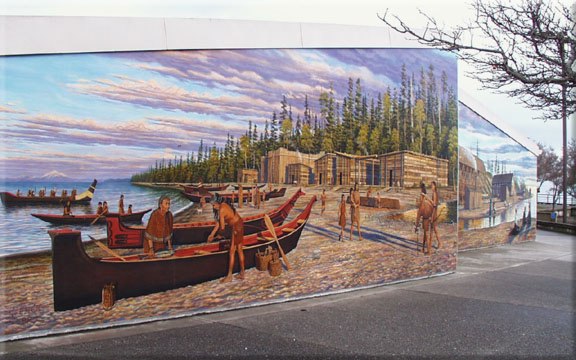
Ennis Creek
Mural |
This page contains 9 images of this mural.
Left Half, Klallam Village
I-en-nus

The left half of this mural depicts how the Klallam Village at Ennis Creek on the Strait of Juan De Fuca may have looked in the late 1700s. |
Brief Historical Background
|
"Their chief Yates-sut-sook received me with great cordiality. I remained with them three days, and all the tribe treated me with kindness". These are the words of Paul Kane a frontier artist who wrote this of the Klallams when he visited their village at Ennis Creek in the early 1800`s prior to the founding of Port Angeles, WA, located on the Olympic Peninsula on the Strait of Juan De Fuca. Kane also sketched, painted and wrote about the Klallam people and their village. His work was a valuable source of reference material for this mural. Another source was the Klallam people themselves with special appreciation to their elders. The name Klallam means strong people in their native tongue. They were primarily a hunting gathering culture but also practiced forms of agriculture. When European explorers first sailed these waters the Strait of Juan de Fuca was dotted with Klallam villages such as the ones at Dungeness, Port Townsend, Victoria and the one at Ennis Creek. It is very likely that the village at Ennis Creek had existed in one form or another for a very long time. Archeologists unfortunately do not have enough information to reconstruct the past history of I-en-nus very far into the past. It is known however that people did inhabit this area long enough to develop a language, culture and way of life based on the local plants, trees and other resources unique to the northwest including a breed of dog whose hair was similar to wool and was used for weaving. Today many Klallam cultural and traditional practices continue among native people on the Olympic Peninsula. |
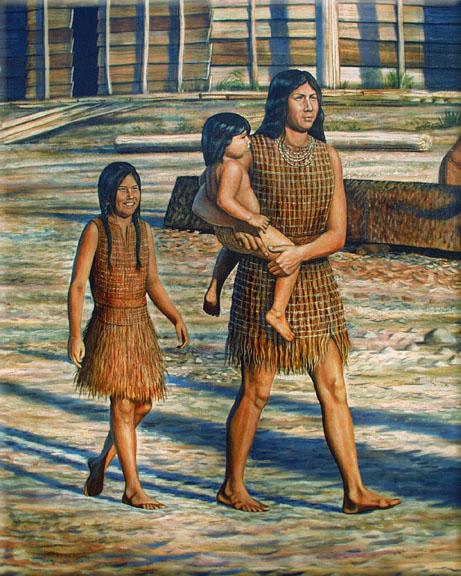
The cedar tree was one of the greatest gifts to the Northwest's Native American Cultures. Everything from clothing to canoes could be made from the different parts of the cedar tree. Here you see a woman with children wearing clothes made of woven cedar bark. In the background is a longhouse made of hand split and carved cedar planks and a canoe being carved from a single cedar tree. |

The cedar dugout canoe was the main means of transportation of these coastal inhabitants. Today the canoes and their spirit are making a comeback with annual tribal journeys organized by the local Northwest Tribes. |
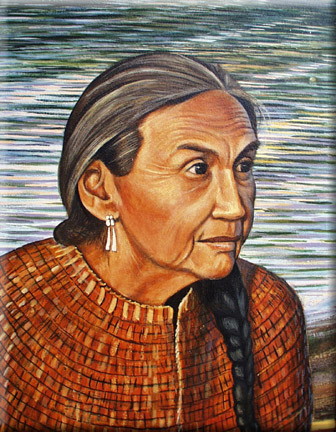
I give many thanks to the Klallam people who modeled for me and helped to give this mural more authenticity. I also thank them for the many great stories I heard and history I learned from them. |
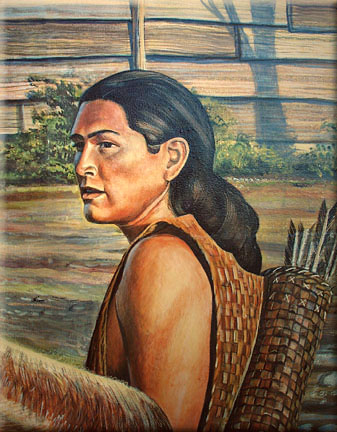
Besides fishing, hunting also was an important part of surviving in the Northwest. Before the introduction of guns there are accounts of the incredible archery skills of the Klallams. |
Right Half, The Puget Sound Cooperative Colony
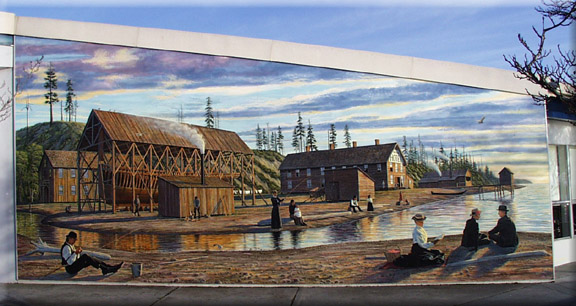
Brief Historical Background
The right half of this mural depicts the Puget Sound Cooperative Colony around 1889 at the
mouth of Ennis Creek. The Cooperative Colony was unique among most early American
settlements in the West and played an important role in the development of Port Angeles.
Its founders, frustrated with the world as they found it, decided to create their ideal of
a utopian society. Culture would be a priority and the Cooperatives property would be
owned and operated by all members for the good of all. Advertised nation wide, people came
by the hundreds from Seattle and all over the country to join this brave new effort.
|
.
Cooperative Colonist woman reading a book. In this mural I tried to focus on the similarities and the unique qualities of the Native Americans and the Pioneers that moved here with their European Heritage. A written language was one of the unique characteristics of the imported European culture although the native people did have pictographs and carvings that would tell stories. |

A visitor at the West End Hotel might try their hand at catching one of the plentiful salmon that filled the streams during the spawning seasons. I found a number of old photos of people out fishing dressed up in what seems like their best clothes and therefore depicted this man likewise. |
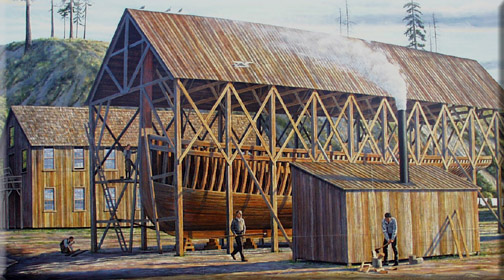
The first ship built in the new town of Port Angeles was a 50' steamer depicted here under construction |